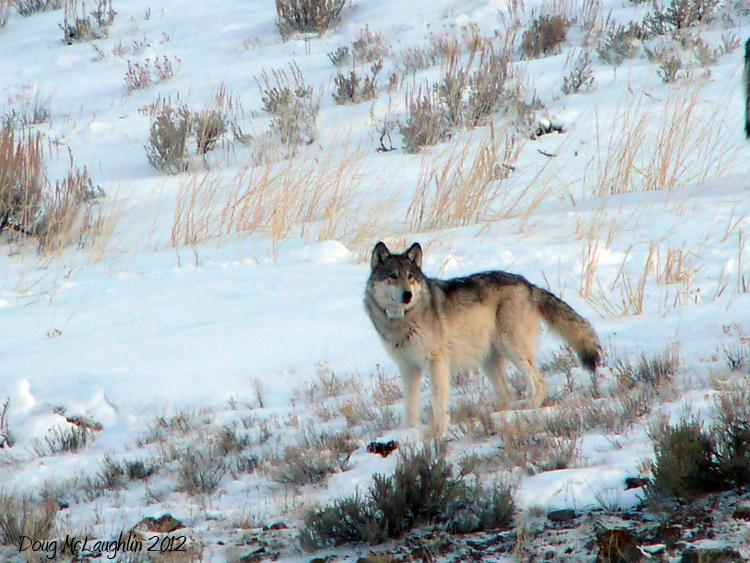
Journalist Nate Blakeslee chronicles the life of a wolf in the Rockies and the forces both natural and human that shape her destiny. His new book is “American Wolf: A True Story Of Survival And Obsession In The West.”

Blakeslee tells Colorado Matters Wild wolves were systematically hunted and by the 1920s they were mostly exterminated in the American West. In the mid-1990s, wildlife managers reintroduced wolves in Yellowstone National Park. He says the program's success gave researchers opportunities to see wolf behavior rarely observed in the past. But it wasn't just scientists watching the wolves, it was tourists too.
O-Six, a wolf named for the year she was born, was a descendant of the reintroduced wolves. She and her pack became well known to parks visitors and millions of people around the world through social media. Blakeslee, who's based in Austin, Texas, uses her story to illustrate the political and cultural battle over wolves in the West. The book is set in Yellowstone National Park, but in the not-too-distant future Colorado could have a similar story.
- As Colorado Commissioners Fret Over Wolves, The Feds Work To Bring In More
- Mexican Gray Wolves Don't Belong In Colorado, Commission Tells Feds
Read an excerpt:
The wolves drove an elk down the side of a steep, snow-covered butte under a sky close and gray. There were three wolves. The one in the lead was almost pure white. She was followed closely by her sister, a good-size gray. Several yards back and struggling to keep up was a mature black male, his snout and withers gone silver with age. The elk had been one of many cows atop the butte; now she was alone, hurtling pell-mell toward the broad valley below, dodging the lichen-covered glacial erratics—some the size of small cabins—that dotted the hillside, leaping over what she could, and exploding straight through the sage and juniper. It was early winter, and the snow was not yet deep, offering the kind of footing that favored the elk. For such an enormous animal—at least five times heavier than any of her pursuers—she was surprisingly fast and nimble. Her chocolate ears laid back against her head, her bouncing, ovoid rump the same shade of buff as the sedge poking up through the snow, she seemed an impossible quarry. The cow headed for the river, as her kind often did when the wolves came. The deep water offered long-legged animals an advantage: a swimming wolf has no leverage for biting and pulling. Chases often ended in stalemate this way, with an elk standing in hip-deep water, warily eyeing a pack of wolves lounging on the nearby bank as they patiently waited to see if the frigid water would force the elk back onto dry land. The refuge the cow sought was the Lamar River, not far from where it joined the Yellowstone, and on this winter morning it was frozen solid. Perhaps she didn’t know that, or perhaps in her panic she could think of nowhere else to go. It was only five hundred yards or so from the base of the butte to the river, but once the chase reached level ground, the wolves began to close the gap. The four animals were now in single file, running flat out, pounding the snow into a fine powdery spray, like the dust under a racehorse’s hooves. The contest had become purely a matter of speed, and the canines—the primordial ancestors of the greyhound, unsullied by the inbreeding that stripped away the tiger-muscled shoulders, the massive head, the powerful jaws—ran with a raw and joyous energy that the ungulate could not match. As the race neared its climax, it was the gray who stood out. Her body seemed to stretch and elongate as the ground swept beneath her. Her legs were long—much longer than a dog’s—and her hips narrow, like a cheetah’s. She held her tail straight out, and her head was a flattened triangle. She was an arrow, and by comparison the elk suddenly seemed not only clumsy but also excessively—sadly, fatally—upright. Every time the cow missed a step, stumbling slightly in a pocket of deep snow, she had less time to recover, until finally there was no time at all. The wolves pulled her down in a frozen marsh between two icy ponds. About a quarter of a mile away, a man stood on the side of a road watching the wolves eat. His name was Rick McIntyre, and he worked for the National Park Service. Bundled in a heavy black down coat that extended past his waist, only the familiar forest green of his pants marked him as a park employee. He was in an area of Yellowstone known as Little America, where the Lamar River swept through a series of low hills and rocky knolls in the park’s mountainous Northern Range. Rick was sixty years old, though with his ramrod posture and tall, lean frame, his age was hard to guess, especially with a stocking cap covering his thinning red hair. He was surveying the scene through a spotting scope, a kind of tripod-mounted telescope used for watching wildlife. Every so often he reached inside his coat and pulled a microcassette recorder from the breast pocket of his uniform and described what he was seeing. Just a few words, economical and to the point. Then the recorder disappeared back into the coat. For the most part, he stood motionless behind his scope, silently watching. It was nine a.m. on December 12, 2009, and it was the 3,467th day in a row that he had spent in the park, looking for wolves. It was getting close to lunchtime for Rick, who had been awake since about four that morning. The wolves were often active at dawn, and he liked to be in place when the landscape first became visible, about a half hour before actual sunrise. Both the male and the white female in his scope, a mated pair, wore thick leather collars with radio transmitters attached, which was how he’d found them. Every pack in Yellowstone had at least one wolf that had been darted from a helicopter, collared, and assigned a number by the park’s small team of wolf biologists. Each morning Rick drove until the antenna on the roof of his yellow Nissan SUV picked up a wolf ’s unique signal, and then he stepped out into the darkness to scan the nearby landscape with his handheld receiver. As he watched the trio of wolves tugging at the elk carcass, Rick found his eye drawn back to the gray female. She had no collar, which meant she had not been given a number, but she did have a nickname: O-Six, for the year in which she had been born. At this range, his scope revealed every detail; she might as well have been sitting at his feet. She was a wonderful specimen, with a dense coat and a heavier physique than most females, who averaged around ninety pounds. Not much usually distinguished one black wolf from another, but every gray was different. O-Six had unusually attractive markings—a faint black oval around each eye, offset by twin wedges of white along the bridge of her nose. Her cheeks were also white, and an unbroken streak of gray ran from the tip of her head to the end of her nose, tapering off into buff along the sides of her snout. The overall effect was of a vaguely owl-like mask, which gave her a look of quiet concentration. Reprinted from AMERICAN WOLF: A TRUE STORY OF SURVIVAL AND OBSESSION IN THE WEST © 2017 by Nate Blakeslee. Published by Crown, an imprint of Penguin Random House LLC. |









